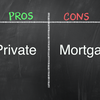Exploring the Rise of Accessibility in Private Mortgages During 2024

Private Mortgage Market Dynamics
Private mortgages have long been seen as the riskier and less attractive alternative to a traditional bank loan. In recent years, however, following the rise of interest rates and stress test requirements, many Canadians found themselves unable to pass through the strict qualifications of traditional lenders.
The private mortgage market, like any other industry, is ruled by the laws of supply and demand. Recently, private mortgages have gained popularity amongst buyers and lenders alike, namely due to their flexibility in requirements, and allowance for quick access to funds. As big bank mortgages became less accessible, the demand for non-traditional loans rose sharply, which in turn increased the supply of top private mortgage lenders in Canada, as new entrants sought to take advantage of this growing market.
Private Mortgages: Pros, Cons, and Regulatory Framework
In Ontario, private mortgages are subject to the Mortgage Brokerages, Lenders and Administrators Act (MBLAA), which regulates mortgage brokerages, mortgage administrators, and mortgage lenders. The MBLAA sets out requirements for licensing, advertising, disclosure, and dispute resolution processes to protect consumers and ensure the integrity of the mortgage lending industry.
Within the private mortgage industry, there are pros and cons involved for both lenders and borrowers. One major pro for lenders is that private mortgages often have higher yields than other types of investments. Here are some common pros for borrowers:
- Accessibility: Private mortgages can provide financing options for borrowers who may not qualify for traditional bank loans due to factors such as poor credit history, self-employment, or unconventional income sources.
- Flexibility: Private lenders often have more flexibility in their lending criteria and can tailor loan terms to meet the specific needs of borrowers, such as offering interest-only payments or shorter loan terms.
- Speed: Private mortgage transactions can often be completed more quickly than traditional bank loans since they typically involve less paperwork and fewer regulatory hurdles.
For lenders, one major con associated with private mortgages is the increased risk of borrower default. For borrowers, the most commonly-listed cons include:
- Higher Interest Rates: Private mortgages often come with higher interest rates compared to traditional bank loans, which can result in higher borrowing costs for borrowers.
- Regulatory Uncertainty: The regulatory framework surrounding private mortgages in Canada is not as robust as that of traditional bank lending, leading to greater uncertainty and potential for abuse or exploitation.
- Limited Consumer Protections: Borrowers may have fewer consumer protections when obtaining a private mortgage compared to a traditional bank loan, making it essential for borrowers to fully understand the terms of the loan and seek legal advice if necessary.
Driving Forces Behind Affordability: Economic Factors and Market Conditions
Several economic factors and market conditions influence mortgage affordability in Canada, affecting both homebuyers and lenders. Key driving forces include:
- Interest Rates: The Bank of Canada's monetary policy, particularly its decisions on the benchmark interest rate, significantly impacts mortgage affordability. Lower interest rates reduce the cost of borrowing, making mortgages more affordable for homebuyers. Conversely, higher interest rates increase borrowing costs, potentially reducing affordability.
- Housing Prices: Market conditions, including supply and demand dynamics, influence housing prices, which in turn affect mortgage affordability. In regions with strong demand and limited housing supply, prices tend to rise, reducing affordability. Conversely, in markets with oversupply or declining demand, prices may stabilize or decrease, improving affordability.
- Employment and Economic Growth: Employment levels, wage growth, and overall economic conditions impact mortgage affordability. Strong economic growth and low unemployment rates generally support higher incomes and improved affordability. Conversely, economic downturns or job losses can reduce affordability as household incomes decline.
- Government Policies: Government interventions, such as mortgage lending regulations, taxation policies, and housing market interventions, can affect mortgage affordability. For example, changes to mortgage stress test rules or down payment requirements can impact homebuyers' ability to qualify for mortgages and afford housing.
As the Canadian economic landscape continues to shift, we may see changes in mortgage affordability following projected rate cuts or the inflow of promised affordable housing supply. In the meantime, however, many Canadians are choosing to forego waiting on the sidelines until traditional mortgages are accessible again and opting for private mortgages instead.
Mitigating Risks Associated with Private Mortgages
The best risk-mitigation strategy boils down to conducting due diligence. For borrowers, this means carefully assessing your financial situation and ensuring you can afford the terms of your private mortgage, including the interest rate and repayment schedule. Seeking independent financial advice and legal counsel can help you understand the terms of the loan and any potential risks involved. Additionally, you could consider obtaining title insurance to protect against title defects or ownership disputes that could affect the property securing the mortgage.
For lenders and investors, mitigating risks involves conducting comprehensive risk assessments of potential borrowers and properties, including assessing creditworthiness, property valuations, and market conditions. Implementing rigorous underwriting standards and stress-testing scenarios can help identify and mitigate potential risks before extending credit. Diversifying investment portfolios across different asset classes and geographic regions can also help spread risk and minimize exposure to any single borrower or property. Moreover, maintaining adequate reserves or liquidity buffers can provide a cushion against unexpected losses or market downturns.
Overall, proactive risk management strategies, thorough due diligence, and diversification are essential for mitigating the risks associated with private mortgages. To learn more about private mortgages and receive personalized advice on how to best approach the current market, you may want to consider working with a Clover Mortgage broker. Contact us today to schedule a free consultation!
FAQ
What are the cons of private lending?
Here are some potential cons to consider:
- Private lending typically involves higher interest rates compared to traditional lending institutions.
- There's often limited regulatory oversight with private lending, exposing both lenders and borrowers to increased risk.
- Private lenders may face higher credit risk, as they often cater to individuals or businesses with poor credit history.
- Transactions may lack transparency, leading to misunderstandings or disputes.
- Private loans are also illiquid investments, making it challenging to access funds once lent out.
- There's a constant risk of borrower default, necessitating legal action and resulting in losses for the lender.
- Market fluctuations and dependency on borrower performance further compound risks.
- Private lending offers limited diversification, potentially exposing lenders to concentrated risks within their portfolios.
Why do people get private mortgages?
People may choose private mortgages over traditional ones for a number of reasons, despite facing higher interest rates. One common reason is that private lenders often provide more flexibility in their lending criteria compared to traditional banks, making it possible for borrowers with lower credit scores or unconventional financial situations to secure funding. Additionally, the process of obtaining a private mortgage can be faster and less bureaucratic than going through a traditional lender, which can be particularly appealing for individuals or businesses in need of quick access to funds. Private mortgages also provide an alternative for those who may not qualify for traditional loans due to factors such as self-employment, non-standard income sources, or unique property types. Moreover, some borrowers may prefer the confidentiality and personalized service offered by private lenders, as well as the ability to negotiate terms directly. Overall, people turn to private mortgages for their flexibility, speed, accessibility, and tailored solutions to specific financial needs.
What are the interest rates for private lending in Canada?
As of April 2024, private mortgage rates range from around 10% to 18% on average, whereas bank interest rates typically hover around 7%.





